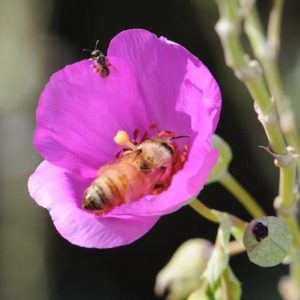Bumblebees greet spring with unrestrained exuberance, appearing to gleefully romp from one poppy blossom to the next. In reality, these bees are hard at work, diligently gathering pollen and nectar to take home to their nest. In so doing, they move pollen from one flower to another to help produce yet another crop of next year’s flowers, seed and food. Bumblebees are primo pollinators.
WHO ARE THE BUMBLEBEES? Bumblebees are large, hairy, yellow and black bees that boisterously buzz flowers from early spring to late fall. There are about 240 species of Bombus worldwide with 26 that are native to California.
Due to their hairiness, bumblebees look larger than they really are. Their hair helps gather and hold pollen during their travels from flower to flower and helps warm them during cold weather. They also have the ability to shiver for warmth and, unlike honeybees and a number of other pollinators, can fly from near-freezing weather to into the 90s. Further, many bumblebees have unusually long tongues enabling them to reach the inner parts of flowers other bees cannot. And, they increase crop production by buzz pollinating (sonicating) tomatoes, blueberries, eggplants, and some pepper blossoms.
Unlike social honeybees that form large hives, bumblebees are semi-social. A single female starts a colony in the spring in an abandoned rodent hole or tree cavity. By season’s end, the nest may contain only 50 to 250 bees. All of the bumblebees then die except a single fertilized female, who starts a new colony in the spring. Since they don’t over-winter in the colony, bumblebees do not stockpile honey as do honeybees.
A garden or yard can easily house a bumblebee nest, perhaps several, without your even knowing. Since bumblebees live in small nests, they never swarm. And, since they produce only small amounts of honey for their own needs, bumblebees have no need to protect their hives from honey thieves. Although a bumblebee can sting more than once, they are quite unlikely to attack humans unless their life is threatened. In fact, the smaller male drones that hatch in midsummer have no sting at all.
THE PLIGHT OF NATIVE POLLINATORS: Pollinators are crucial to our food supply. Without pollinators, we will lose most fruit crops, many vegetables and grains, even chocolate. Honeybees (non-native European bees) are our best-known pollinators, and their decline due to disease, mites, and “colony collapse” has received much press.
Fortunately, we have 1,600 species of known California bees, including bumblebees, plus many other native pollinating insects, bats, and birds. These native creatures often have greater resistance to local diseases and parasites, and their diversity makes it less likely that a disease would impact all.
Even so, our native pollinators are under a siege that has been compared to global warming. The advent of chemical gardening and increased agriculture last century took a great toll. Industrialization and urbanization continue to reduce nesting areas and eliminate many native plants that pollinators depend on. And, ongoing importation of exotic (non-native) bees, including European bumblebees for greenhouse tomato pollination, potentially brings more new diseases.
WHAT TO DO: We all have the power to help bumblebees and other pollinators in some way. Embrace non-chemical solutions to pest problems and eliminate pesticide powders and dusts, as pollinators can carry them back to the nest. Encourage schools, parks, golf courses, and other public entities to use fewer pesticides and to let ditches and hedgerows go unplowed and unsprayed to preserve nesting sites. Let native plants (including some weeds) grow undisturbed whenever possible.
And, if you can, plant a few pollinator flowers or even a pollinator garden. Pollinators prefer their flowers in patches, rather than single plants, and need a succession of blossoms from spring through fall.
The California Native Plant Society recommendations include California poppies, sunflowers, lupine, clover, California lilac, penstemon, gooseberries, salvias, milkweeds, and manzanita. For more flower suggestions, go to http://nature.Berkeley.edu/urbanbeegardens. Also visit The American Pollinator Protection Campaign at www.nappc.org.
Sonora UCCE Master Gardener Vera Strader is an avid bumblebee watcher. Her yard is certified as a National Wildlife Federation Backyard Wildlife Habitat. She is a University of California Cooperative Extension Master Gardener of Tuolumne County. UCCE Master Gardeners of Tuolumne and Calaveras Counties can answer home gardening questions, call 209-533-5912 Fill out our easy-to-use problem questionnaire here. Check out our website here, You can also find us on Facebook.

